 Last additions - Otsu 大津市 Last additions - Otsu 大津市 |

May 12, 2009
|
|

Grounds of Sakamoto Castle site (Honmaru) on the lake shore.May 12, 2009
|
|

May 12, 2009
|
|

May 12, 2009
|
|

May 12, 2009
|
|

Beach at the site of Sakamoto Castle.May 12, 2009
|
|

May 12, 2009
|
|

Statue of Akechi Mitsuhide at Sakamoto Castle site.May 12, 2009
|
|

Sakamoto Castle markerMay 12, 2009
|
|

May 12, 2009
|
|

Saikyoji temple cemetary.May 12, 2009
|
|

Site of Sakamoto Castle, now a small park on the west shore of Otsu.May 12, 2009
|
|

Unimpressive beach at the site of Sakamoto Castle.May 12, 2009
|
|

Columbarium.May 12, 2009
|
|

Maybe this was where the castle once stood? Picnic pavilion now.May 12, 2009
|
|

Temple belfryMay 12, 2009
|
|

Statue of Akechi MitsuhideMay 12, 2009
|
|

Statue of Priest Shinsei ( 真盛) as a boy. Founder of Tendai Shinsei Sect to which Saikyoji belongs.May 12, 2009
|
|

Saikyoji is noted for the grave of Akechi Mitsuhide, the lord of Sakamoto Castle and temple patron who helped to reconstruct the temple.May 12, 2009
|
|

May 12, 2009
|
|

May 12, 2009
|
|

May 12, 2009
|
|

The temple is full of other graves and monuments.May 12, 2009
|
|

Main altar of Saikyoji's Hondo hall. May 12, 2009
|
|

May 12, 2009
|
|

May 12, 2009
|
|

May 12, 2009
|
|

May 12, 2009
|
|

May 12, 2009
|
|

Grave of Akechi Mitsuhide's wife Tsumaki Hiroko. 妻木煕子May 12, 2009
|
|

Other altars in Saikyoji's Hondo hall. May 12, 2009
|
|

Stone marker indicating Saikyoji as the headquarters of the Tendai Shinsei Sect.May 12, 2009
|
|

May 12, 2009
|
|

May 12, 2009
|
|

May 12, 2009
|
|

Doors of Saikyoji's Hondo hallMay 12, 2009
|
|

May 12, 2009
|
|

Inside Saikyoji's Hondo hall.May 12, 2009
|
|

Grave of Akechi Mitsuhide who is most famous for assassinating Oda Nobunaga in Kyoto. 明智光秀May 12, 2009
|
|

May 12, 2009
|
|

May 12, 2009
|
|

Main altar of Saikyoji's Hondo hall. May 12, 2009
|
|

Saikyoji temple's Hondo main hall, in Otsu, Shiga. 西教寺 本堂May 12, 2009
|
|
|

Garden at a temple in Sakamoto.May 12, 2009
|
|

May 12, 2009
|
|

May 12, 2009
|
|

Gate to a temple in Sakamoto.May 12, 2009
|
|

May 12, 2009
|
|

May 12, 2009
|
|
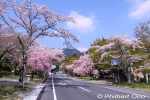
Hiyoshi Baba roadMay 12, 2009
|
|

Map showing Sakamoto's historic preservation area. Sakamoto is a National Important Traditional Townscape Preservation District (重要伝統的建造物群保存地区).May 12, 2009
|
|

Stone temple wall in Sakamoto, Otsu.May 12, 2009
|
|

Typical stone walls in SakamotoMay 12, 2009
|
|

Hiyoshi Baba road in central Sakamoto. On the right is Mt. Hachijoji. 日吉馬場May 12, 2009
|
|

Smaller temples along the way.May 12, 2009
|
|

Path going to Saikyoji temple's Hondo hall. This would be pretty during cherry blossom season.May 12, 2009
|
|

May 12, 2009
|
|

Gate to Saikyoji temple. Saikyoji is a 20-min. walk from central Sakamoto.May 12, 2009
|
|
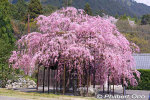
Weeping cherry tree at Hiyoshi Taisha Shrine in Otsu.May 12, 2009
|
|

Directions to Hiyoshi Taisha Shrine and the cable car station.May 12, 2009
|
|

Gate of Shiga-in Monzeki temple.May 12, 2009
|
|

Sakamoto Station on the Keihan Ishiyama-Sakamoto Line. Sakamoto is a short walk from this train station. MAPMay 12, 2009
|
|

May 12, 2009
|
|
|
|

Stone wall in Sakamoto, Otsu.May 12, 2009
|
|

Sakamoto Station on the Keihan Ishiyama-Sakamoto Line. This station is closer to Sakamoto than the JR Hiezan-Sakamoto Station.May 12, 2009
|
|

Torii gate for Hiyoshi Taisha Shrine on Hiyoshi Baba road which is today the main drag of Sakamoto leading to the shrine. Apparently, this road was a horse running course.May 12, 2009
|
|
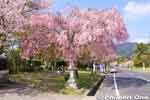
In Sakamoto, Hiyoshi Baba road is lined with various cherry trees that bloom in mid-April.May 12, 2009
|
|

JR Hiezan-Sakamoto Station on the JR Kosei Line accessible from Kyoto and Yamashina Stations.May 12, 2009
|
|

Apr 30, 2009
|
|

Mikoshi bearers were standing by at Wakamiya Port and one by one they offloaded the mikoshi from the barge.Apr 30, 2009
|
|

The mikoshi return to land at Wakamiya Port.Apr 30, 2009
|
|

Barge loaded with mikoshi approaching Wakamiya Port. Sanno-sai Festival.Apr 30, 2009
|
|

Apr 30, 2009
|
|

Apr 30, 2009
|
|

Mikoshi bearers are taken by bus to the boat dock at 七本柳の浜 which was too far away for me to reach in time.Apr 30, 2009
|
|

Hiyoshi Taisha torii on the shore of Lake Biwa. This is not where they load the boat with the mikoshi.Apr 30, 2009
|
|

Wakamiya Shrine near Wakamiya Port.Apr 30, 2009
|
|

Sanno-sai Festival, Hiyoshi Taisha Shrine, Otsu, Shiga PrefectureApr 30, 2009
|
|

Apr 30, 2009
|
|

The mikoshi departed by boat at 3 pm. They were put on a barge pulled by a tugboat. The barge sailed off the coast of Karasaki Shrine where they held a ceremony.Apr 30, 2009
|
|

They carried the mikoshi on a rainy day on April 14, 2009.Apr 30, 2009
|
|
|

Mikoshi on trucks to transport them to the boat dock.Apr 30, 2009
|
|

The mikoshi pass under the Sanno torii.Apr 30, 2009
|
|

Apr 30, 2009
|
|

Then the mikoshi sailed to Wakamiya Port. 船渡御Apr 30, 2009
|
|

Apr 30, 2009
|
|

Sanno-sai Festival, Hiyoshi Taisha Shrine, Otsu, Shiga PrefectureApr 30, 2009
|
|

Passing under another torii facing Sando road.Apr 30, 2009
|
|
|

Sanno-sai Festival, Hiyoshi Taisha Shrine, Otsu, Shiga PrefectureApr 30, 2009
|
|

At 2:30 pm, they started carrying the mikoshi.Apr 30, 2009
|
|

神輿神幸Apr 30, 2009
|
|

Apr 30, 2009
|
|

Ceremony in front of a shishi lion head.Apr 30, 2009
|
|

Apr 30, 2009
|
|

Three of the mikoshi were put on trucks.Apr 30, 2009
|
|

Heading down Sando road.Apr 30, 2009
|
|

Carrying the mikoshi through Romon Gate at Nishi Hongu.Apr 30, 2009
|
|

One after another, they carried out the seven mikoshi.Apr 30, 2009
|
|

They passed through the Romon Gate.Apr 30, 2009
|
|

Four of the mikoshi were to be carried by humans. Apr 30, 2009
|
|

Mikoshi ornaments were then installed on the mikoshi.Apr 30, 2009
|
|

Returning the large sakaki branch from Tenson Shrine. 大榊還御Apr 30, 2009
|
|

Apr 30, 2009
|
|

Apr 30, 2009
|
|

It was done with great fanfare.Apr 30, 2009
|
|

Apr 30, 2009
|
|

Apr 30, 2009
|
|

Apr 30, 2009
|
|

Apr 30, 2009
|
|
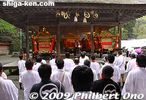
After the sakaki branch ceremony, at 1:30 pm they held the Haiden Departure Ceremony at the Haiden where seven mikoshi were placed. 拝殿出し神事Apr 30, 2009
|
|

At 1 pm, they held the Large Sakaki Branch Returning Ceremony at Nishi Hongu. The branch was returned from Tenson Shrine (天孫神社/西宮神社). Sakaki is a type of evergreen sacred to Shinto. 大榊還御Apr 30, 2009
|
|

They then carried the mikoshi from the Haiden to the Sando road.Apr 30, 2009
|
|

Apr 30, 2009
|
|

Sacred Horse (dummy) on a small truck proceeds around the shrine at 1 pm. I wonder how they did this in the old days. 御浦神事Apr 30, 2009
|
|

People head for Nishi Hongu where the mikoshi are.Apr 30, 2009
|
|

Mikoshi bearers run through Nishi Hongu's Romon Gate.Apr 30, 2009
|
|

Apr 30, 2009
|
|

The Tendai Abbot leaves Nishi Hongu in a procession of Buddhist priests.Apr 30, 2009
|
|

Ceremony attendees.Apr 30, 2009
|
|

Mikoshi bearers on Sando road make their way to the shrine.Apr 30, 2009
|
|

After the Reisai Ceremony, the Tendai Abbot leaves Nishi Hongu through the Romon Gate.Apr 30, 2009
|
|

The Tendai Abbot leaving Nishi Hongu.Apr 30, 2009
|
|

Nishi Hongu Haiden Hall has the mikoshi portable shrines.Apr 30, 2009
|
|
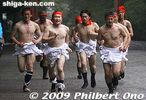
Mikoshi bearers run to the shrine.Apr 30, 2009
|
|

Festival participants make their way to the shrine.Apr 30, 2009
|
|

Apr 30, 2009
|
|

The Tendai Abbot offers the sacred branch.Apr 30, 2009
|
|

Apr 30, 2009
|
|

THe head priest of Hiyoshi Taisha greets the Tendai Abbot.Apr 30, 2009
|
|

Evidence of how close Shinto and Buddhism were in past centuries in Japan.Apr 30, 2009
|
|

Apr 30, 2009
|
|

Interesting to see Buddhist priests chanting Buddhist sutras in front of a Shinto shrine.Apr 30, 2009
|
|

Apr 30, 2009
|
|

Apr 30, 2009
|
|

More bowing between priests.Apr 30, 2009
|
|

It was raining this day on April 14, 2009. This is the Romon Gate to Nishi Hongu.Apr 30, 2009
|
|

Tendai Zasu Abbot 天台座主Apr 30, 2009
|
|

The Shinto priests proceed to Nishi Hongu.Apr 30, 2009
|
|

On the left is the Haiden Hall with the mikoshi which were brought there the night before from the Yomiya-jo. Nishi Hongu's Honden (main hall) is on the right. 例祭Apr 30, 2009
|
|

More Tendai priests from Enryakuji temple proceed to Nishi Hongu. Buddhist priests do not wear the flappy cap like Shinto priests.Apr 30, 2009
|
|

The Tendai Zasu Abbot is escorted to the Honden.Apr 30, 2009
|
|

Two more groups arrive while running.Apr 30, 2009
|
|

The Tendai Abbot chants a sutra in front of the Honden at Nishi Hongu. 読経Apr 30, 2009
|
|
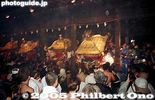
All four groups of men then rocked the mikoshi back and forth. making thunderous noise. Very dramatic. This is called Yomiya Otoshi. 宵宮落し神事Apr 30, 2009
|
|

The Tendai Zasu Abbot proceeds to Nishi Hongu.Apr 30, 2009
|
|

Yomiya-joApr 30, 2009
|
|

The Tendai Abbot receives the sacred branch to be offered at Nishi Hongu.Apr 30, 2009
|
|

Torch bearers arrive at the Yomiya-jo while running.Apr 30, 2009
|
|

There they go, racing to Nishi Hongu Shrine. And that's it for April 13.Apr 30, 2009
|
|

All four groups have arrived and they stand around the mikoshi. There are more people behind the mikoshi as well.Apr 30, 2009
|
|

They stop and after a few speeches, they drop the mikoshi with a bang to symbolize the birth of the child god. Also see my YouTube video here.Apr 30, 2009
|
|

The fun is not over until they start to carry the mikoshi out of the Yomiya-jo. They run with the mikoshi and make it very dramatic (and dangerous if you're in their way).Apr 30, 2009
|
|

Apr 30, 2009
|
|

Next day on April 14, the Reisai day, the schedule is filled with more ceremonies and events. At 10 am, the Reisai ceremony is held at Nishi Hongu with the Tendai Zasu Abbot from Enryakuji in attendance. He is under the red umbrella.Apr 30, 2009
|
|

Apr 30, 2009
|
|

The Tendai Abbot (orange robes) lines up along with other Enryakuji Buddhist priests on the Sando path of Hiyoshi Taisha.Apr 30, 2009
|
|

The first group start to violently rock the mikoshi back and forth.Apr 30, 2009
|
|

The first group arrive at Yomiya-jo and go to their mikoshi.Apr 30, 2009
|
|

Apr 30, 2009
|
|

Another group arrive and position themselves at another mikoshi.Apr 30, 2009
|
|

All the torch groups head for the temple.Apr 30, 2009
|
|

These guys can get pretty drunk as they haul the torches.Apr 30, 2009
|
|

Now at the Yomiya-jo where the four mikoshi are placed. The torch bearers run from the Sando road to Yomiya-jo. This is at around 9 pm.Apr 30, 2009
|
|

Shrine parishioners carry giant torches around the streets of Sakamoto the neighborhood of Hiyoshi Taisha.Apr 30, 2009
|
|

Apr 30, 2009
|
|

The torch procession gather at Shogenji temple at 7 pm on April 13.Apr 30, 2009
|
|

Apr 30, 2009
|
|

Shogenji temple where all the torch bearers will gather later. Shogenji is a Tendai Buddhist temple on the Sando road. 生源寺Apr 30, 2009
|
|

Young ceremony assistants.Apr 30, 2009
|
|

April 13 climaxes in the evening with the Yomiya Otoshi Ceremony starting with a torch procession around the streets near Hiyoshi Taisha from 6 pm.Apr 30, 2009
|
|

Hiyoshi Taisha's Nishi Hongu (West) Shrine. This building is a National Treasure. 西本宮Apr 30, 2009
|
|

Apr 30, 2009
|
|

Afterward, they move to Hiyoshi Taisha's Nishi Hongu Shrine.Apr 30, 2009
|
|

Assistants stand on the steps of the Nishi Hongu.Apr 30, 2009
|
|

The next ceremony is the Hitsuji Offering Ceremony conducted by parishioners from Hiyoshi Jinja Shrine in Kyoto. Starting at 3 pm on April 13, this ceremony has been conducted for many centuries since the Heian Period. 未の御供献納祭Apr 30, 2009
|
|

The Hitsuji offerings include arrows, bells, brushes, dolls, flowers, and sweets. Priests give prayers as they deliver the offerings.Apr 30, 2009
|
|

Apr 30, 2009
|
|

Apr 30, 2009
|
|

The offerings are given to the four mikoshi at the Yomiya-jo storehouse.Apr 30, 2009
|
|

Samurai warriors in the Flower Procession.Apr 30, 2009
|
|

Apr 30, 2009
|
|

Apr 30, 2009
|
|

Hi kids!Apr 30, 2009
|
|

Some kids get tried and end up being carried.Apr 30, 2009
|
|

Family portrait with the chigo child.Apr 30, 2009
|
|

The Flower Procession ends at the Yomiya-jo where they bless the child in front of the mikoshi. This Flower Procession ceremony costs the proud, doting parents big bucks.Apr 30, 2009
|
|

Apr 30, 2009
|
|

Apr 30, 2009
|
|

THe Flower Procession is held to celebrate the birth of the shrine's child god. Therefore, this event centers on the parent-child connection.Apr 30, 2009
|
|

Little kids in ceremonial dress for this fesival are called chigo. 稚児Apr 30, 2009
|
|

Apr 30, 2009
|
|

Apr 30, 2009
|
|
|
|

Flower Procession, Sanno-sai Festival. There are two escorts wearing ceremonial aprons and they drag a wand over the road. Apr 30, 2009
|
|

Apr 30, 2009
|
|

Apr 30, 2009
|
|

Flower Procession on Sando 花渡り式Apr 30, 2009
|
|

Spectators come to see their classmates in the procession.Apr 30, 2009
|
|

Flower Procession. They walk slowly and deliberately with parents and relatives in tow. 花渡り式Apr 30, 2009
|
|

At 1 pm on the Sando main road leading to Hiyoshi Taisha Shrine, the Flower Procession (Hana-watari-shiki) is held with little kids dressed up as nobility. Apr 30, 2009
|
|

The procession includes samurai.Apr 30, 2009
|
|

Monkey carvings on a mikoshi. The monkey is the messenger of the mountain god.Apr 30, 2009
|
|

Flower Procession draws large crowds.Apr 30, 2009
|
|

The Sanno Festival (in Japanese it's called Sanno-sai, not Sanno Matsuri) consists of a myriad of festival events. Also interesting is the participation of Buddhist priests from Enryakuji temple atop Mt. Hiei.Apr 30, 2009
|
|

After the Tea Offering Ceremony, they march back.Apr 30, 2009
|
|

The four mikoshi at the Yomiya-jo storehouse.Apr 30, 2009
|
|

Apr 30, 2009
|
|

The Tea Offering Ceremony is held at the Yomiya-jo where the four portable shrines (mikoshi) are placed. 宵宮場 大政所Apr 30, 2009
|
|

These photos were taken on April 13-14, 2009. I still have to see the other ceremonies.Apr 30, 2009
|
|

The tea is offered to each of the four mikoshi which had been brought down from Mt. Hachioji the night before. The tea is said to bring safe childbirths.Apr 30, 2009
|
|

The Sanno-sai Festival is held annually on April 12-15 at Hiyoshi Taisha Shrine in Otsu, Shiga Prefecture. Not to be confused with the Sanno Matsuri held by Hie Shrine in Tokyo. It centers on April 14, the shrine's most important day called Reisai.Apr 30, 2009
|
|

Apr 30, 2009
|
|

Delivering the tea.Apr 30, 2009
|
|

Apr 30, 2009
|
|

Delivering the tea.Apr 30, 2009
|
|

On April 12, they raucously bring down portable shrines from Mt. Hachioji nearby in the evening. On April 13, they hold a series of ceremonies including this one called the Tea Offering Ceremony at 11 am. 献茶祭Apr 30, 2009
|
|

Hiyoshi Taisha is at the foot of Mt. Hiei (home of Enryakuji temple) and it worships the mountain god. The Sanno-sai festival is the shrine's biggest festival and one of Shiga's biggest festivals. MAPApr 30, 2009
|
|

Hiyoshi Taisha's tea field is said to be Japan's oldest. Tea picked from this field is presented to the gods housed in the portable shrines.Apr 30, 2009
|
|

Biwako Sosui. The city of Otsu is thinking about resurrecting a tourist boat service on this canal. MAPApr 23, 2009
|
|

Lake Biwa Canal No. 1. The Lake Biwa Canal (Biwako Sosui) supplies water from Lake Biwa in Otsu to Kyoto. After four years of monumental construction, the canal was completed in 1890. Apr 23, 2009
|
|
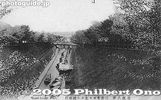
Lake Biwa Canal on vintage postcard. Notice the boats in the canal. Boat rides were initially offered.Apr 23, 2009
|
|
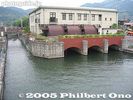
Lake Biwa Canal No. 1Apr 23, 2009
|
|

Lake Biwa Canal No. 1Apr 23, 2009
|
|

Lake Biwa Canal and cherry blossoms.Apr 23, 2009
|
|

No. 1 Tunnel entrance. The first and longest tunnel under a mountain. The entrance is very artistic.Apr 23, 2009
|
|

Apr 23, 2009
|
|
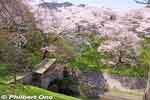
Apr 23, 2009
|
|

Lake Biwa Canal and cherry blossoms in full bloom. They also light up the trees at night from 6:30 pm-9:30 pm. Beautiful and serene.Apr 23, 2009
|
|

Lake Biwa Canal and cherry blossoms above the tunnel entrance.Apr 23, 2009
|
|

Apr 23, 2009
|
|

The Biwako Sosui or Lake Biwa Canal in Otsu is also noted for cherry blossoms.Apr 23, 2009
|
|
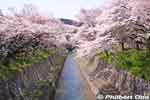
Lake Biwa Canal (Biwako Sosui) and cherry blossoms. This is one of two canals which supply water from Lake Biwa to Kyoto. National Historic SiteApr 23, 2009
|
|

Apr 23, 2009
|
|

Apr 23, 2009
|
|

Apr 23, 2009
|
|

Inside Onjoji Akaiya is the sacred spring whose water is drawn to be offered in front of the temple altar. The water was also used to bathe the newborn Emperor Tenji, Tenmu, and Jito. The name Miidera (Three Wells) comes from this spring.Apr 23, 2009
|
|

It's a huge bell. After hearing the sound of the bell on Mt. Hiei, Benkei was disgusted with how it sounded and threw the bell back down the mountain.Apr 23, 2009
|
|

Inside Kondo Hall, built in 1599. Miroku Bosatsu statue is the object of worship.Apr 23, 2009
|
|

This small building houses a temple bell which, according to legend, warrior monk Benkei from Enryakuji stole from Miidera and carried up to Enryakuji on Mt. Hiei.Apr 23, 2009
|
|

Inside Kondo Hall.Apr 23, 2009
|
|

Kondo Hall roofApr 23, 2009
|
|

Kondo Hall corner wood beamApr 23, 2009
|
|

Next to Kondo Hall is a small building called the Onjoji Akaiya, an Important Cultural Property. 閼伽井屋Apr 23, 2009
|
|

Kondo HallApr 23, 2009
|
|

Kondo Hall and cherry blossoms.Apr 23, 2009
|
|

Kondo HallApr 23, 2009
|
|

Kondo Hall verandaApr 23, 2009
|
|

Miidera temple's Kondo Hall, a National Treasure and Miidera's main worship hall built in 1599 in Otsu. 金堂Apr 23, 2009
|
|
| 2449 files on 10 page(s) |
 |
 |
6 |  |
 |
|